HOME | DD
 mayshing — Paneling tips for manga
mayshing — Paneling tips for manga

Published: 2004-06-12 01:00:23 +0000 UTC; Views: 131135; Favourites: 1516; Downloads: 8730
Redirect to original
Description
Paneling is a part of Graphic design. O_- It's an art in itself, think of how you would do a collage and put together a puzzle, that's how paneling works.You must understand the basic 2D design element:
movement, center of interest, value contrast, volume, size, perspective.... so on and on....
As for paneling.... there is no set way to do it, whether drawing the picture first, or draw the panel's first, or draw the panels and the pictures back and forth.... it's all upto the artist, as long as the result is satisfying to the artist. Just experiement and find the best way that suits you.
1. Panels must support your content: That's the most important thing.... if one line is going over an important character's head shot, omit that line and let the character stand out~ If one frame is more important than the other, you wish to make it a focus on the page, make that frame larger than the others, sometimes it can even overlap other panels alittle. However, being overly complicated with the panel works will also confuse the viewers instead of supporting the content, one must find a good balance.
2. Movement: Panels MUST be able to direct the viewers themselves, other than the different universal rules of reading left or right, the panels should work its own magic directing the viewer. "What will the viewers see first on this page? what will the viewer see as the second panel on this page?"
Design your panels with that question in mind, when needed, ask a friend to check what they would see first.
Make sure it's not too complicated that it would confuse the viewer, leave enough nagetive space, and make sure there is a "flow" in their arrangement.
Attention grabbers:
a. Size matters: Bigger panels tend to get attention first, bigger text tend to be read first.
b. Iconic graphics: An eye, a face, a mouth, something easy to recognize tend to get attetion first.
c. Contrast: The part of your page with the most contrast tend to get attention first.
After you know what grabs your readers first on a page, you can plan for orders of the panels 1>2>3>4 ... etc. At that point you have created a flow, a movement of the eyes and how it goes through a page.
3. Depth: Panels can create depth on one layout, think of the panels as its own art, this is where basic 2 D design concepts come in, if you take away all the content in your panels would the panels still look interesting? Sometimes one panel can jump out more than the others, so make sure it's creating the depth you wanted.
4. Variety: Lines that divide the panels can break, it doesn't have to stay closed or as rectangles. If you think that having the space in between the panels would make it look too rigid, omit that space and use only one line, sometimes you can use textures instead of a normal line to express what you want.
A mini test: Close your eyes, then open it again in front of your page, and see where you immediately see, that would be the central focus on your page, if you have a problem checking ask someone else to help you.
5. Sizes: Bigger panels almost always get attention first. Big head shots tend to get attention first.
Try to get big when it needs to be, be small when it needs to be. Small and large panels all have their own power and their own usage.
You can use sizes of the panels or characters to determine where your readers' eyes will go to.
When you want to impact your viewers, use spread page. (Two pages at once for one single illustration, make sure you have the first page of the spread page on EVEN number, the second page on ODDS. So it would print right.)
6. Express: Make the panels express your idea, rather than trying to make them interesting, when it can successfully help you to express the content, it will be a successful paneling work no matter what styles.
7. Composition: Design all panels as ONE composition, not two, not three, ONE composition for 1 page, and this composition should continue to link to the next pages if needed. Make all panels work as one composition instead of each one drifting on their own, then your page will look more together instead of having the panels each as their own individuals, then you can avoid a lot of conflicts between the panels.
8. Numbers of panels: A lot of you asked me: "How many panels should there be on one page?"
One universal rule is: "NO more than 10 panels."
Some publishers prefer to have "No more than 5 panels on a page."
This is according to the size of your book, most of the mangas are printed small, 5"X7" (the ones in Asia are even smaller) Small panels will make shrunk text hard to read, and make the images hard to see. Bigger panels are encouraged.
I used to do 5-8 panels on a page, now I do no more than 5, with occasional 7-9 for special effects. (ex: an action took place and everyone in the group is shocked. Then I will illustrate small, mini panels with a shot on everyone's face, and the major center panel has the action.)
9. Different styles of panels suit different graphics: (general guide from publisher)
If your manga/comic is illustrated with crazy insane amount of details, then sturdy, steady, and simple panels will help to hold your content in place
If your manga/comics has less content and has a simpler style that relies on movement and special effects, then you can try more fancy way to play with the panels.
My own preference: There's no set rule on what you can use, and what you can't, what really really matters is that your panels must HELP your content to be read easily, back to the first point.
If you go fancy on the panels and yet people become confused by it, then its best you go back to the simple styles first and nail down camera shots, composition basics and adjust your detailing and illustrations before you move onto other types.
I would encourage beginners to start with the simplest panel to make story telling work before they go to play fancy with it.
10. Text, Text balloons are a part of the paneling.
Plan the placement of your text on a manga/comic page WITH YOUR PICTURES together.
It will make an easier read. I know now of days, digital medium makes doing things separately easier, many draw their pictures completely separated from the text, that's ok. But it's not okay to do your panels without having a plan for your text placement, you may make some mistakes that can make layout chaotic and make a page harder to read.
Any manga that's not an easy read tend to get dropped a lot quicker.
Comic/manga is a medium with both words and pictures, so make them one, at least plan them together.
General guide from publisher: "If you are planning your page without text, leave the page a bit empty, then when the text in placed in, it would be just about right."
A good practice of paneling, believe it or not is abstract art, playing with the basic elements of art, shape, and black and white, for example, just play with rectangles and see how many interesting composition you can come up with.
-Personally, sometimes I have panels layout in my mind with the pictures all together, it has fused into my system, it's a part of my composition... but other times, when I only have the content in mind, I just go on to draw them one by one and figure out how to solve them together in sketch.







You get a bit of what I am saying? ^^b
Related content
Comments: 218

👍: 1 ⏩: 0

thanks for this awesome guide! back then my min-max manga panels per page was 8-14 without storyboard planning and it's not so fun to that anymore at this point so I changed my method to make 1-8 manga panels per page with storyboard planning first
👍: 0 ⏩: 0

love this tips... i am just about to start making a short comic. and i am confuse about paneling. this is really help me out! ^w^
👍: 0 ⏩: 0

Love to see people talk about paneling rather than just drawing. Paneling is so important! I took a class with a professional manga creator, and he spend 4 hours teach us how to use panel and text balloon to tell a story and express emotion and movement, which is absolutely useful!
👍: 0 ⏩: 0

I know some manga and comics do this, but when would you say is the best "time" in a page/panel set up to use black? What I mean is, for example, you fill in your white page background with black but not the backgrounds of the individual panels? Lol does that make sense to anyone? I know they do this and have read manga with this exact thing, but for the life of my I can't remember what this is exactly called NOR do I EVER remember to take pictures of the titles or scenes in the comics/manga that I read with this exact instance! - _ - If you have no idea what I'm talking about, no worries. If you do, may the force be with you and please share your knowledge! lol Thanks
EDIT: I found this image online and thought it'd help explain what I tried to say lol
images-na.ssl-images-amazon.co…
👍: 0 ⏩: 1

the common language for black framing in b/w manga is "flash back" and "memory" of someone.
That's what I would use it for.
For western colored comics however, black doesn't mean much except framing and making the panels stand out more.
👍: 0 ⏩: 1

Thank you! As soon as I read this I literally did a face palm because every time I come across this instance it is for flash backs or memory type deals lol I just added this to one of my manga pages so I hope I did it properly. Thanks again!
👍: 0 ⏩: 1

Huge thanks for the tips! Really detailed and informative
I might need these quite a bit ^^
👍: 0 ⏩: 1

Thanks for the help! I'm doing a Nuzlocke hand-drawn, so this really helps me out!
👍: 0 ⏩: 1


👍: 0 ⏩: 1

This is helpful! Thank you for taking the time to make this! ^^
👍: 0 ⏩: 0

thanks for the help.. I did a doodle and hated the way it just stood out on the page so i turned it into a panel and I've never worked with this type of art before and your information about placement was helpful.. I am sure when I am done it will be far from perfect but better than it would have been if I tried alone
👍: 0 ⏩: 0

A question, I'm doing a 3 page project on 18 x 24 drawing paper. How many panels would you reccomend for a piece of that size
👍: 0 ⏩: 1

depends on how its read, how far do u want it to read?
If you want people who walk into the room before reaching it to read it immediately, just treat it as if its 8X11 size and do panels the same way. You just have a large page as a result.
If you want someone to read it a long time on the wall where the first panel is not too higher up from them, (just need to make sure the top roll is easy to read) then you can fit more panels into it. Like 3 times the normal amount.
👍: 0 ⏩: 1

its a short story, 3-4 pages. I think your first suggestion works. Thank you
👍: 0 ⏩: 0

This tutorial was made a few years ago but it still managed to help me (who just saw this a few moments ago). Cool tutorial. Thanks!
👍: 0 ⏩: 0

this is so helpful thank u so much
i lke how u did it so organized this is going to be helpful in the future
thank u so much!!!
👍: 0 ⏩: 0

This makes my job SO much easier! Thank you so much! I've been aspiring to become a manga artist and writer, and this was perfect! I can't wait to start!
👍: 0 ⏩: 0

This is going to help a lot when I start doing the first storyboards....
👍: 0 ⏩: 0

This is interesting. My favorite part is 1>2>3>4. What a fun way of writing it. Movement helped me the most. It's hard to get myself inspired so I have to read around until I feel "I can do it!" Your article definitely helped a bit! Thank you~
👍: 0 ⏩: 0

Thanks! This is really useful...
Though it's interesting to note that most manga pages are divided into 3 sections, with all the panels contained in the top, middle, and bottom sections....
Gonna go use this now to try to make my own manga..
👍: 0 ⏩: 0

this is really good explanation, with this i can make my own manga 
👍: 0 ⏩: 0

i always get confused with the even and odd numbering when creating a manga, i don't get (Two pages at once for one single illustration, make sure you have the first page of the spread page on EVEN number, the second page on ODDS. So it would print right.)
can you please explain? xD
👍: 0 ⏩: 1

its about the printing, if your picture is on ODDs (1, 3, 5, 7)
it will be on the front of the page, and the next page will be put on the BACK of the odd page.
But if you draw the 1 comp on the EVEN (2, 4, 6) then the next two pages can connect, it's a basic printing knowledge.
If you want to figure it out for sure, test it on paper,
print a few pages and stick them together to make your own book
in order of the page number, with spreads on different numbers, then you will understand.
👍: 0 ⏩: 1

oooh i think i sort of get it now ^.^ thank you
👍: 0 ⏩: 0

How is text added to finished manuscripts (traditional, on paper)? I've always wondered how text is put on to manucripts! Is it added on the computer after completion or is the text printed out and glued?
👍: 0 ⏩: 1
| Next =>




























